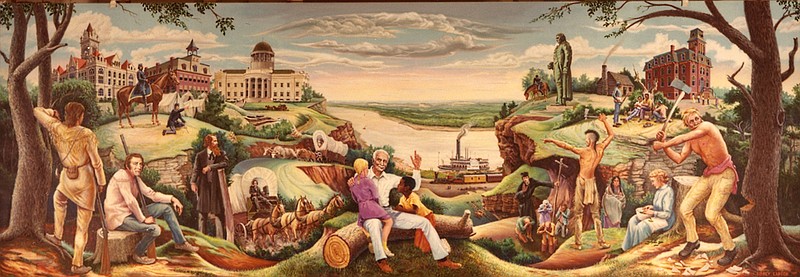The origins of Jefferson City are portrayed in Sidney Larson's "Story of Jefferson City" mural in the main floor atrium of City Hall. The work was dedicated in September 1985, along with the Cole County Nexus, an abstract tapestry map of the city, by Linda Eyerman. The Art at City Hall project was directed by the Environmental Quality Commission but funded with private donations from individuals, businesses and heritage organizations.
An art professor for more than 50 years at Columbia College, Larson was paid $20,000 for the 5-by-18-foot acrylic on Belgian linen mural. At the time, he also was curator of art at the State Historic Society of Missouri.
The limestone cliffs and Missouri River provide the setting. The background features early buildings of the city's key government entities - county, city, state and university.
The current Cole County Courthouse is depicted at the far left in the mural. It was built in 1896 by local architect Frank Miller and rebuilt after the 1918 fire.
Beside it is Bragg Hall, the first city hall, built before 1873 by Major Joseph Clarke. An original fourth floor was a theater for more than a decade, a skating rink and a box factory. After a top-floor fire, the first bell tower was constructed on top. The first floor was originally a livery and later the People's Tribune newspaper offices.
Clark left Bragg Hall to the city in his 1880 will, with the stipulation of a memorial room with a life-sized bronze statue of himself and portraits of his wife and two sons be included there. The city government continued to operate out of the building for more than half a century.
Next shown is the second Missouri state Capitol, built in 1840 and expanded in 1888, which was destroyed by fire after a lightning strike in 1911. Its architect, John Withnell, and the Irish laborers also helped to build the first St. Peter Church.
On the right side, Lincoln Institute's lost Memorial Hall, opened in 1872, was the first building on what became the Lincoln University hilltop campus. Soldiers from the 62nd and 65th U.S. Colored Infantry regiments founded the school so other newly freed citizens could learn as they had during their military service. The institute's first classes were held in the public school's discarded two-room cabin that stood where the former Simonsen 9th Grade Center is on Miller Street.
The Little Osage and Missouri tribes were displaced from this area by white settlement. This had been their hunting ground, which they often went to war with other tribes to protect, before the 1808 treaty that ceded their claims to lands in Missouri. Before the Osage, other prehistoric populations lived in the area, leaving behind dozens of burial mounds later looted and removed by settlers.
Explorers Capt. Merriweather Lewis and Lt. William Clark are shown in buckskins on the left. Their Corps of Discovery was sent by President Thomas Jefferson, on the mural's right, to explore the Louisiana Purchase. Jefferson paid $15 million to France in 1803 for the territory that doubled the size of the young nation. The military expedition camped near the future Capitol on June 4, 1804.
Belgian aristocrat Father Ferdinand Helias is shown in the mural carrying a cross. Helias arrived in Central Missouri as a Catholic Jesuit missionary at age 42, serving 35 years and establishing eight parishes, including St. Peter.
The man chopping down a tree and his wife shelling peas represent the German settlers. The first wave of German immigrants arrived in Central Missouri in the 1830s seeking land similar to their homeland.
Gov. B. Gratz Brown, a tall, red-haired gentleman, leans on a post with a dueling pistol in his right hand. He was governor from 1871-75 and participated in the state's last duel opposite Thomas Reynolds in 1856. A newspaperman, Brown married the daughter of Calvin Gunn, who set up the first newspaper, the Jeffersonian Republican, in Jefferson City.
George Caleb Bingham is shown driving a covered wagon. The "Missouri artist" was appointed state treasurer in 1861 and secured the state's treasury in St. Louis at the start of the Civil War.
Gen. John Fremont is shown on horseback at Camp Lillie, the Union headquarters established at the Dulle House on St. Mary's Boulevard. Fremont briefly was in charge of the Department of the West when he arrived in September 1861. Gen. Nathaniel Lyon and Union troops disembarked from the packet-type sidewheel boat, Iatan, at the boat landing near the Missouri State Penitentiary in June 1861 in pursuit of the elected Gov. Claiborne Jackson, who was run out of the state for his southern-sympathy views.
As May is Historic Preservation Month, it is fitting to highlight this piece of art that tells the city's story. Residents are encouraged to look up when walking through the front door of City Hall.
Michelle Brooks is a former reporter for the Jefferson City News Tribune. She particularly is interested in recording the history of city-designated Landmarks and Lincoln University's first century.

